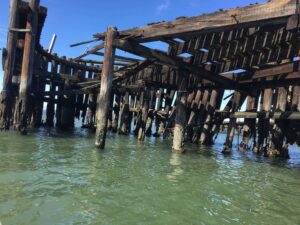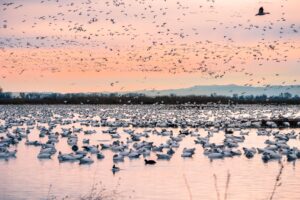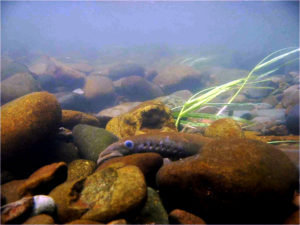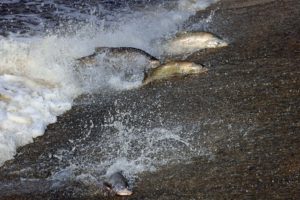Oh swimmers / This is the dream given by you / to be the way of my / late grandfathers when they first caught you at your playground in this river…Why should I not go to the end of / the dream given by you?
“Prayer to the Salmon,” Kwakiutl song
We walked up Devil’s Gulch today—my dog Gus and I—along a well-worn forest trail, across a slope of reaching oak, through bare-stemmed hazelnut and sword fern, past a fire-hollowed redwood tree, to see if the salmon had returned to spawn yet. The creek is running strong now, bankfull and still clouded with early season runoff from the recent rains. We hear the song of a winter wren echo from a narrow side-canyon that cuts off to the north, and the sharp scolds of jays and fox sparrows in the shadowy glen of bracken and bay. Beneath a punky log I turn out the first Ensatina I’ve seen since last autumn and hold it in my open palm, letting Gus sniff it cautiously. The salamander’s smoky skin seems translucent, and it cranes its neck and blinks its eyes like a waking baby. Gus loses interest momentarily and I carefully place the Ensatina back under the bark. Gus is intent on smelling every stump and clump of shrub, taking in the scent of every raccoon and bobcat that has traveled here, intent as I am on the water, looking for the certain ripple or telltale rooster-tail in the current.
- Two coho males swimming in a tributary of Olema Creek. The whitening ofthe dorsal fin spines is the result of sparrring between males foraccess to gravid females. Photo by Greg Brown, courtesy of NationalPark Service.
In this west Marin watershed, known as Lagunitas Creek, the rivulets and tributaries that drain the northern slopes of Mount Tamalpais and its subordinate flanks and hogbacks have supported a salmon spawn since long before the First People settled here, before there were cattle or even deer. When this weather pattern of winter rain and summer drought developed in the California coast range, perhaps as long as eight million years ago, some of the earliest settlers were salmon—coho and steelhead—along with salamanders and the redwoods. They are here still, but long gone are the grizzlies that used to come down to the creek side and hide in the undergrowth waiting for the salmon run. Mostly gone are the tule elk that grazed among the hummocks of tall perennial grasses with lovely names — Agrostris, Deschampsia, Calamagrostris — that used to grace this place. These, too, have mostly disappeared or taken refuge on a few steep cliffs or roadcuts where no cattle are able to graze. Gone, or mostly gone, are the Miwok who lived along these banks for maybe 8,000 years and in these stream beds leached their acorns and built their weirs of hazel wand and willow sapling to catch the salmon on their upstream runs.
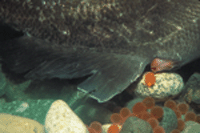
- A female coho lays her eggs in a depression she has created in the gravel. Photo by Sidnee Wheelwright.
Though these others have faded from the creek’s banks into the shadows of the past, the salmon, through some combination of tenacity and will, survive still, still manage to navigate through a labyrinth of obstacles to their ancestral breeding and dying beds, still braid the streams with their passage. At least for now.
I sit on a moldering log on the bank and watch the water. The leafless willow thickets are tinged bronze, russet as a salmon’s flank. When the creek runs full, as it does today, the willow roots drown in the overflow, and the stalks shiver in the current and cast quavering shadows across the ground. This early season salmon walk has become an annual pilgrimage for me. In other years I’ve come with my wife when she had time for desultory walks, with my children when they were young enough to be surprised, or alone when the shortening days and overcast skies promised a long rainy winter ahead. Now my companion is young Gus, who’s again got his nose to the trail and his tail wagging with each new subtlety of scent—fox scat, bobcat, or mountain lion sign. With others or alone, I always arrive with mixed emotions, hope and concern: hope that the salmon may be here, concern that perhaps this year they won’t come at all. Today we walk about an hour upstream and find no sign of salmon; but it is early, the first opportunity, really, to even suspect they might have returned. I’m not too concerned.

- A male coho leaps over the dam at Roy’s Pools on San Geronimo Creek. Photo by Reuven Walder, courtesy of SPAWN.
When winter rains begin, the early season runoff flows out into Tomales Bay and carries with it the musky essence of this watershed: detritus of alder leaves and redwood bark; decomposed ’coon and bobcat scat; fine sediments acrid with the scent of basalt, greenstone, and graywacke; molecules of bracken and bay; even the calcium and keratin of generations of salmon ancestors. On falling tides of the solstice moon this turbid soup plumes into the Gulf of the Farallones. Now the ocean-running coho begin to coalesce just offshore.
During the second and third years of their lives, these salmon range in silver schools along the continental slope and beyond, through the cold upwelling waters of the Pacific, north perhaps as far as the Bering Sea, south as far as the convergence of currents off Point Conception. The movements and behavior of the coho diaspora are not well known, but it is thought that they follow the migrations of anchovy and other small schooling fish along current confluences and temperature clines.
We do know that after two years at sea, the coho congregate in schools near the mouths of the rivers where they were born, staging, awaiting the clues—changes in salinity or temperature—that the stream is swollen and cool enough for passage. How salmon manage to migrate over great distances and return to their natal streams is still a mystery, but we do know that their sense of smell is perhaps the most acute in the animal kingdom, that they can discriminate between different streams, and, apparently, discern the singular scent of their own birth stream. That first year of life spent in the home stream provides not only a nursery period of growth and nourishment, but also a phase of what biologists call “olfactory conditioning.”
If they survive their oceanic odyssey, with its multiple threats of predation by seals, sharks, and seine nets, the mature coho gather to face the struggle upstream to the riffles of their birth. This journey varies, of course, from stream to stream and year to year. Lagunitas Creek offers the same obstacles that occur in many other streams: dams, fallen trees, landslides, otters, toxic contamination that has leached or been dumped into the stream, and water shallow from diversion, muddied by cattle, or warmed by removal of riparian vegetation.
If and when homeward-bound salmon manage to surmount these obstacles, the female will find a bed at the bottom of a chattering riffle where the gravel is fine, so she can sift it with sideways body waves, winnowing out a shallow depression—a “redd”—in which to shed her eggs. This she will do progressively upstream, burying the eggs below with the gravel winnowed from the next redd upstream. Then the male, waiting in the shallows, his sides blushed red as sunrise, will follow her upstream and spread his milt over the freshly laid eggs. When her cache of eggs and his reserves of milt are spent, each will swim to the shallows, or the shade of an undercut bank, and wait to die.
By the time the young hatch out of the gravel bed as “alevin,” 40 to 60 days after fertilization, the bodies of their parents have decomposed, and been absorbed into the nutrient pool of the stream. The young salmon—if it survives predation by kingfishers, steelhead, and other fingerlings—spends at least the first year of life in the freshwater neighborhood of its birth. These streams must be well-oxygenated and cool; the salmon fry cannot tolerate temperatures above about 70 degrees Farenheit and are therefore restricted to sections of stream with sufficient vegetative cover and shade—overhanging willows and alders, deeply incised channels, and undercut banks—to maintain fairly low temperatures. These conditions also provide habitat for the young salmon’s food: insect larvae, opossum shrimp, and other small prey items. Because the year-old fry will leave for the ocean the following fall, after growing to about six inches, the surge of early winter runoff that can spirit them downstream is crucial to each generation. Also crucial is an “estuarine reach” of creek where the fresh and brackish waters intermix, providing habitat where the young fish can undergo the physiological changes, known as smolting, necessary for surviving the transition from fresh creek to salty ocean water.
At least that’s our version. Other peoples who have inhabited the banks of salmon streams at other times have different stories. For the Coast Salish people, the salmon were beings who lived in their own world, much like people, but came yearly as fish to give their flesh to humans, who were obliged to treat them properly. The salmon were carried carefully by the children, cooked in a special way, and eaten by all; after, their bones were returned to the water from which they came. In several cultures salmon are said to wink at women, and a woman seduced by the salmon’s charms will bear twins. The Kwakiutl people of the Northwest coast believe that twins are descended from salmon and, therefore, don’t permit their twin children to venture near the river for fear they might become fish again. To other Northwestern tribes, salmon are the souls of dead children or ancestors returning to the village.
This Lagunitas Creek watershed, my window into the salmon cycle, used to run undammed from the northern flanks of Mount Tamalpais, draining the hills and canyons behind Woodacre, Forest Knolls, and Lagunitas, an area of well over 100 square miles. With its numerous gravel beds well-sifted and well-oxygenated by upstream rapids and numerous merging freshets and trickles, this watershed must have supported an abundant salmon run until the late 1800s. Despite the years of logging that occurred upslope, despite the paper mill that drew and quartered redwood lumber downstream, despite the narrow gauge railroad trestle that squeezed the creek banks along much of its lower reach, despite the summer inn that was perched above one of the largest pools, the salmon persisted.
Lagunitas Dam was constructed near the headwaters of the creek in 1873 and probably eliminated a short stretch of headwater habitat. Then in 1918, Alpine Dam was built, interrupting flow about a third of the way downstream, flooding breeding pools, and impounding water that used to flow downstream. Though their habitat was diminished, the salmon still survived. It wasn’t until after World War II, with the human population explosion along Marin’s Highway 101 corridor, that county planners began their most prodigious efforts to capture as much Lagunitas Creek water as possible and move it out of the watershed, to the faucets and spigots of the mushroom- ing bedroom communities of San Rafael, San Anselmo, Corte Madera, and other towns.
Shortly after I was born in 1947, the Marin County Water District constructed Bon Tempe Dam (1948) and then Peter’s Dam to create Kent Lake (1953), effectively arresting outflows for more than half the length of Lagunitas Creek. In 1960 Nicasio Creek, the main downstream tributary of Lagunitas Creek, was also dammed, capturing the runoff from all the canyons west of Big Rock Ridge—Redwood, Bulltail Valley, Halleck, and Nicasio creeks and a thousand unnamed rivulets and arroyos. The size of Peter’s Dam, the largest of the series of dams along the creek, was doubled in 1982, doubling the capacity of Kent Lake and depriving the remnant downstream spawning beds of overflow, especially during low water years.
In addition to all this damming, the mouth of the creek at Tomales Bay was converted into grazing land for dairy cows with the construction of a series of levees in 1947. A seasonal dam was placed near the mouth of the creek to irrigate and desalinate this “reclaimed” pasture, thereby obstructing the outmigration of young salmon in spring and causing an abrupt shift from fresh water to salt where there had once been a gradual estuarine shift in salinity.
The scale of Marin County water impoundment projects, and the conversion of essential wetlands to agricultural, residential or commercial uses, was duplicated up and down the Pacific Coast during the same time period. The predictable result has been a tremendous diminution in the stocks of most species of salmonids.
Under the Endangered Species Act, an “evolutionary signi-ficant unit,” or ESU, of a given species—a population that is geographically separate and has distinct genetic and ecological characteristics—is afforded the same legal protection as a full species. In 1995 the National Marine Fisheries Service began a comprehensive survey of each ESU of the coho population and estimated that the California population had declined from one million individuals in the 1940s to fewer than 6,000. Based on the Service’s estimates, the population in the Central California ESU (from southern Humboldt County to Santa Cruz) was listed as threatened (“likely to become extinct within the foreseeable future”) in October of 1996. Lagunitas Creek supports about 10 percent of the salmon in the Central California ESU; other important runs persist in Redwood Creek (Muir Woods National Monument), Russian River in Sonoma County, and Little River and Caspar Creek in Mendocino, among other sites. All watersheds in private ownership are imperiled by ongoing logging, water diversion, and grazing. In April 1997, the ESU immediately to the north—which includes watersheds of the now notorious Headwaters Forest—was also listed, thereby providing “protected” status for all the coastal streams in California where coho have bred historically.
On the way back down the trail Gus and I cross a small footbridge and half-jog down the fire road, close to where the car is parked, close to where Devil’s Gulch converges with larger Lagunitas Creek. Out of the corner of my eye I see a swirl in a pool below a small cascade and edge my way close to the bank to peer into the water. There, still in the shallows, I can see the subtlest suggestion of a fish-like form, about the length of my forearm, facing upstream, steadying itself with just the slightest fanning of its tail. A gravid female—bronzy sides, black spots along the back, not as red as the male would be, and without the hooked snout. She must be daunted by the next series of basalt boulders, a rise of maybe four feet that will take prodigious effort and determination to overcome. But it is certain that she will try, maybe not right now, but later, when some other fish have come and the pool is too crowded to stay, or with the next surge of runoff from upslope when the water level rises, or its temperature chills ever so slightly.
My annual ritual of returning to this remnant stretch of creek and seeking out the salmon spawn is not unique to me. Others have stood on this same creek bank, with the same sense of wonder, with the same mixture of hope and foreboding. And when that first gravid female is encountered, facing up current, determined, waiting for the right time, the foreboding is replaced by relief, a release of tension—another cycle complete.
In the old days before the dams, when the streams were free, in villages like Olema-loke, Echa-tamal, Shotomko, when the days shortened and Raven, black like the clouds, soared in circles over the ridge gathering the weather, the First People began to prepare for the return of the salmon . . . as they pounded acorns—“umpa”—the women kept an eye on the stream, always watching to see if it had changed color. Then one day, suddenly, the stream would turn to red, red as the breaking dawn. The salmon had come, their flanks illuminating the water.
The women yelled out to the rest of the village—“kaasi! kaasi!”—and everyone ran down to the bank to see the red water. The boys came two at a time, helping each other carry the six-foot weirs they had been weaving from willow boughs all autumn. The young girls brought the best baskets, the ones woven with the black stems of maidenhair ferns. The men wore headbands plucked from the scalps of woodpeckers, blood red, like the rising sun, like the salmon’s flanks.
The whole village danced on the bank—old women with their grandsons, brothers with sisters, husbands with wives—thankful that the salmon people had decided to return. Their thankfulness was for more than food and the assurance of a fat winter. The salmon had completed the circle and, so, the world was made new . . .
Recently I was reading an essay in Twentieth Century Pleasures (Ecco Press, 1984) by poet Robert Hass, who happened to have spent his boyhood on the banks of Lagunitas Creek. Hass credits an unidentified poem by Kenneth Rexroth as the encounter that first informed him of the connection between poetry and his own world:
Under the second moon the Salmon come,
up Tomales Bay, by Papermill Creek,
up the narrow gorges to their spawning beds in Devil’s Gulch.
This salmon run, this small stretch of creek, sparks a connection between Rexroth, Hass, myself, and countless others, and arcs a circuitry that connects us back to the earliest inhabitants, to each other and to this place. The salmon are the nerves of this stream, and we feel the stream’s life through their energetic return, a return that spawns our memories and our imaginations and redresses, after all, that distance from the natural world that society promotes.
What is it about the salmon cycle that so involves us, that so connects us to this freshened stream? Certainly the coho itself, returning to its homeland at the solstice, after an heroic journey, seems almost more than an animal, more like the embodiment of a meta­phor for death and rebirth, for tran­scendence and renewal. No wonder the North­west coastal people who depended on the salmon for their winter staple—the Yurok, the Hupa, Mattole, and others—saw the salmon as a god and celebrated the First Salmon with rituals of supplication and propitiation.
Recurrence, repetition, renewal. Again, in Twentieth Century Pleasures, Robert Hass talks about the incantory rhythms of early people, about chants preparatory to the hunt, about the connection between repetition and magic, between memory and inspiration, between nature and poetry. Just as the oral traditions of chant and prayer have engendered poetry, so might the recurrent rhythm of the salmon run, the autumn passage of geese, or the thundering movement of an elk herd evoke in us, in the coiled strands of our being, primeval memories and sensations that tether us to the world. Our senses are attuned, through evolution, to take notice of the shadows in the water, the sounds of hooves in the distance, the honking of geese, the soughing of the trees. We have survived as a species through this paying of attention, through this recognition of patterns in the world around us; we are relieved when the patterns we have understood as integral to our environment play out as we anticipate they should.
We may be reaching the end of that thread of experience, the end of the dream given by you, Coho, and all your kin. That our knowledge of the land and ourselves may not accommodate the annual salmon run—a recurrence that is endemic to this place—is a possibility we can not abide, an unraveling we can not accept.
So next year, when the creek is swollen with early season runoff, when the bare-stemmed willow trembles in the current, when the solstice moon is swollen in the cold December sky, when fox sparrows and winter wrens are calling from the canyons, I’ll come back, maybe alone, maybe with another, to welcome you, Coho, to witness and celebrate your perennial return.

.jpg)

